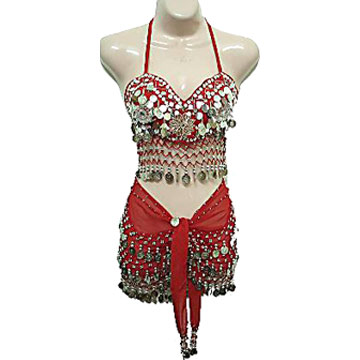Belly Dance Outfits Biography
Belly dance or bellydance is a Western-coined name for a "traditional West Asian" dance, especially raqs sharqi (Arabic: رقص شرقي). It is sometimes also called Middle Eastern dance or Arabic dance in the West.
The term "belly dance" is a translation of the French "danse du ventre" which was applied to the dance in the Victorian era. It is something of a misnomer as every part of the body is involved in the dance; the most featured body part is usually the hips. Belly dance takes many different forms depending on the country and region, both in costume and dance style, and new styles have evolved in the West as its popularity has spread globally. Although contemporary forms of the dance have generally been performed by women, some of the dances, particularly the cane dance, have origins in male forms of performance.
Raqs sharqi (Arabic: رقص شرقي; literally "eastern/oriental dancing") is the style more familiar to Westerners, performed in restaurants and cabarets around the world. It is more commonly performed by female dancers but is also sometimes danced by men. It is a solo improvisational dance, although students often perform choreographed dances in a group.
Raqs baladi, (Arabic: رقص بلدي; literally "local dancing", or "folk" dance) is the folkloric style, danced socially by men and women of all ages in some Middle Eastern countries, usually at festive occasions such as weddings. However, this naming is used synonymously in Egypt with Raqs sharqi as a generic term for "belly dancing".
Belly dance was popularized in the West during the Romantic movement of the 18th and 19th centuries, when Orientalist artists depicted romanticized images of harem life in the Ottoman Empire. Around this time, dancers from Middle Eastern countries began to perform at various World's Fairs, often drawing crowds in numbers that rivaled those for the science and technology exhibits. It was during this period that the term "oriental" or "eastern" dancing was first used. Several dancers, including the French author Colette, engaged in "oriental" dance, sometimes passing off their own interpretations as authentic.
Belly dance or bellydance is a Western-coined name for a "traditional West Asian" dance, especially raqs sharqi (Arabic: رقص شرقي). It is sometimes also called Middle Eastern dance or Arabic dance in the West.
The term "belly dance" is a translation of the French "danse du ventre" which was applied to the dance in the Victorian era. It is something of a misnomer as every part of the body is involved in the dance; the most featured body part is usually the hips. Belly dance takes many different forms depending on the country and region, both in costume and dance style, and new styles have evolved in the West as its popularity has spread globally. Although contemporary forms of the dance have generally been performed by women, some of the dances, particularly the cane dance, have origins in male forms of performance.
Raqs sharqi (Arabic: رقص شرقي; literally "eastern/oriental dancing") is the style more familiar to Westerners, performed in restaurants and cabarets around the world. It is more commonly performed by female dancers but is also sometimes danced by men. It is a solo improvisational dance, although students often perform choreographed dances in a group.
Raqs baladi, (Arabic: رقص بلدي; literally "local dancing", or "folk" dance) is the folkloric style, danced socially by men and women of all ages in some Middle Eastern countries, usually at festive occasions such as weddings. However, this naming is used synonymously in Egypt with Raqs sharqi as a generic term for "belly dancing".
Belly dance was popularized in the West during the Romantic movement of the 18th and 19th centuries, when Orientalist artists depicted romanticized images of harem life in the Ottoman Empire. Around this time, dancers from Middle Eastern countries began to perform at various World's Fairs, often drawing crowds in numbers that rivaled those for the science and technology exhibits. It was during this period that the term "oriental" or "eastern" dancing was first used. Several dancers, including the French author Colette, engaged in "oriental" dance, sometimes passing off their own interpretations as authentic.
Belly Dance Outfits
Belly Dance Outfits
Belly Dance Outfits
Belly Dance Outfits
Belly Dance Outfits
Belly Dance Outfits
Belly Dance Outfits
Belly Dance Outfits
Belly Dance Outfits
Belly Dance Outfits












No comments:
Post a Comment